There is drama in the mountains. They call me to them, and, when I depart,
like all climbers, I am enriched with stories. This page briefly introduces
some of those stories. The thumbnails below -- and the full size pictures
you can see by clicking on them -- hint at the mountain scene.
Mountains
have many routes coming into season at different times of the year. The
first mountain I ever climbed was Mt. Hood (11,235'), a peak I could see
from my bedroom window in Portland, Oregon. Spectacular year round --
I have climbed Mt. Hood 25 times from all sides in Spring, Summer, Fall,
and Winter.  Although
it is one of the most frequently climbed glaciated mountains in the world,
most climbers attempt only the South Side. This picture shows the lesser
known "North Side." From left to right I have ascended the North
Face Cleaver, Elliot Headwall, Sunshine, and the Coe Glacier. The glacier
on the left side, the Elliot, is a late summer playground for ice climbing--also
the site of my worst accident, a swan dive into a 100+' deep crevasse; thank goodness I landed on a clump of snow stuck in the crevasse's throat, only 40' down.
Although
it is one of the most frequently climbed glaciated mountains in the world,
most climbers attempt only the South Side. This picture shows the lesser
known "North Side." From left to right I have ascended the North
Face Cleaver, Elliot Headwall, Sunshine, and the Coe Glacier. The glacier
on the left side, the Elliot, is a late summer playground for ice climbing--also
the site of my worst accident, a swan dive into a 100+' deep crevasse; thank goodness I landed on a clump of snow stuck in the crevasse's throat, only 40' down.
Another peak
that I could see from my house was Mt. St. Helens. 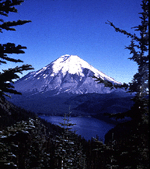 In
the foreground is Spirit Lake where I attended Boy Scout camp --utterly
transformed by the 1980 volcanic eruption. While the explosion filled
the sky over Portland and dropped a thick coat of ash on the city, it
was only later I learned that two friends were killed taking pictures
between the lake and the mountain. I climbed the old St. Helens three
times by different routes from the side you can see here. I remember my first
climb of St. Helens -- all night to reach the top for the sunrise with my friend Blair
Harcourt. Exhausted, both of us feel asleep on the summit.
In
the foreground is Spirit Lake where I attended Boy Scout camp --utterly
transformed by the 1980 volcanic eruption. While the explosion filled
the sky over Portland and dropped a thick coat of ash on the city, it
was only later I learned that two friends were killed taking pictures
between the lake and the mountain. I climbed the old St. Helens three
times by different routes from the side you can see here. I remember my first
climb of St. Helens -- all night to reach the top for the sunrise with my friend Blair
Harcourt. Exhausted, both of us feel asleep on the summit.
The Cascades
are a spectacular range and I have summited most of them. 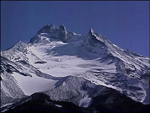 Mt.
Jefferson is the second highest peak in Oregon surrounded by the Warm
Springs Indian Reservation and a gorgeous wilderness area. Glacier travel,
steep snow traverses and a rock pinnacle make even the easiest routes
on Jeff challenging. On one climb of Jefferson I had left a bottle of
Guiness Stout in a snowbank at the base camp. It was cold and delicious
when I returned.
Mt.
Jefferson is the second highest peak in Oregon surrounded by the Warm
Springs Indian Reservation and a gorgeous wilderness area. Glacier travel,
steep snow traverses and a rock pinnacle make even the easiest routes
on Jeff challenging. On one climb of Jefferson I had left a bottle of
Guiness Stout in a snowbank at the base camp. It was cold and delicious
when I returned.
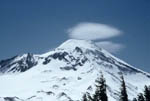 The
Three Sisters are a familiar sight in the Oregon Cascades. This picture
of the most climbed peak in the group, South Sister, shows the rarely
attempted north side. On the right is an ice route called "Silver
Couloir" that I climbed with Craig Henry and Dave Holmberg. By the
way, the lenticular cloud in this picture is an ominous sign the weather
is about to change -- climbers, think twice before going on.
The
Three Sisters are a familiar sight in the Oregon Cascades. This picture
of the most climbed peak in the group, South Sister, shows the rarely
attempted north side. On the right is an ice route called "Silver
Couloir" that I climbed with Craig Henry and Dave Holmberg. By the
way, the lenticular cloud in this picture is an ominous sign the weather
is about to change -- climbers, think twice before going on.
This mountain
is one of the most photographed in the world -- though many might not know
it by name as "Mt. Shuksan" in the North Cascades of Washington
State.  The
climb I made by the Fisher Chimney route was every bit as spectacular
as the picture promises. As assistant leader I incurred the wrath of the
leader Lath Flanagan when, with signals crossed and night descending,
I led half the party off of the mountain before the rest had caught up.
Back in base camp with no word from the leader and missing members, at
2:00 am we began to put together a rescue team. Just as we started off,
Flanagan and the rest stumbled, exhausted to the tents.
The
climb I made by the Fisher Chimney route was every bit as spectacular
as the picture promises. As assistant leader I incurred the wrath of the
leader Lath Flanagan when, with signals crossed and night descending,
I led half the party off of the mountain before the rest had caught up.
Back in base camp with no word from the leader and missing members, at
2:00 am we began to put together a rescue team. Just as we started off,
Flanagan and the rest stumbled, exhausted to the tents.
 Mt.
Rainier (14,410') is the king of the Cascades. It is hard to appreciate
the size of mountains, even when you have climbed them many times. Mt.
Rainier is enormous, with the largest glacial system of any peak in the
US outside of Alaska. I have started up the mountain five times and made
the summit only twice. One successful climb was the "Fuhrer's Finger"
a direct line that runs about straight up the middle of this picture.
Mt.
Rainier (14,410') is the king of the Cascades. It is hard to appreciate
the size of mountains, even when you have climbed them many times. Mt.
Rainier is enormous, with the largest glacial system of any peak in the
US outside of Alaska. I have started up the mountain five times and made
the summit only twice. One successful climb was the "Fuhrer's Finger"
a direct line that runs about straight up the middle of this picture.
The North
West includes mountains other than the Cascades. One of the most beautiful
is Mt. Olympus. 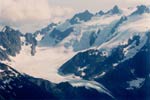 The
Olympic National Park protects the only significant stand of old growth
temperate rainforest in the contiguous United States. The merciless timber
industry has taken the rest, don't let anyone fool you about that. This
picture of Olympus shows the Blue Glacier. Once, carefully roped crossing
the heavily crevassed glacier, I saw a large wolf trotting by about 200
yards below us.
The
Olympic National Park protects the only significant stand of old growth
temperate rainforest in the contiguous United States. The merciless timber
industry has taken the rest, don't let anyone fool you about that. This
picture of Olympus shows the Blue Glacier. Once, carefully roped crossing
the heavily crevassed glacier, I saw a large wolf trotting by about 200
yards below us.
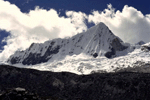 I
have summited two peaks in the Cordillera Blanca of the Peruvian Andes,
Pisco
(over 19,000)' on the left, and Tocllaraju
(over 20,000') on the right.
I
have summited two peaks in the Cordillera Blanca of the Peruvian Andes,
Pisco
(over 19,000)' on the left, and Tocllaraju
(over 20,000') on the right. 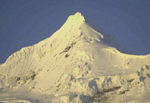 Each
climb required five days past villages, across glaciers, with high camps
in magnificent spots. As our party reached the long ridge on Pisco (above)
spectacular peaks suddenly came into view. At the same moment, a dense low cloud
blew over just above us; it felt as if I could just reach up and put my
hands inside it.
Each
climb required five days past villages, across glaciers, with high camps
in magnificent spots. As our party reached the long ridge on Pisco (above)
spectacular peaks suddenly came into view. At the same moment, a dense low cloud
blew over just above us; it felt as if I could just reach up and put my
hands inside it.
 My
greatest mountaineering accomplishment was as a member of the 1982 Tirich
Mir Expedition. The highest peak in the Hindu Kush range of the Himalayas,
Tirich Mir is in Northwest Pakistan, on the Afghan border. 25,253' high,
it is a massive mountain and significant objective. (There are only 14 peaks in the world over 26,000'.)
My
greatest mountaineering accomplishment was as a member of the 1982 Tirich
Mir Expedition. The highest peak in the Hindu Kush range of the Himalayas,
Tirich Mir is in Northwest Pakistan, on the Afghan border. 25,253' high,
it is a massive mountain and significant objective. (There are only 14 peaks in the world over 26,000'.)  This
six week expedition involved fifty low elevation porters and eight climbers,
Bob Wilson (leader), John Smolich (asst. leader), Lath Flanagan (physician),
Dennis Olmstead, Tom Gordon, Terry Jones, John Dasler, and myself -- the
team's youngest climber. We were all members of the Portland-based Mazama
Mountaineering Club. With
the support of the whole team, four of us made the summit, John, John,
Dennis, and I. We believe that
This
six week expedition involved fifty low elevation porters and eight climbers,
Bob Wilson (leader), John Smolich (asst. leader), Lath Flanagan (physician),
Dennis Olmstead, Tom Gordon, Terry Jones, John Dasler, and myself -- the
team's youngest climber. We were all members of the Portland-based Mazama
Mountaineering Club. With
the support of the whole team, four of us made the summit, John, John,
Dennis, and I. We believe that 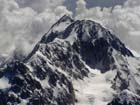 we were the first Americans to climb Tirich
Mir. We established four high camps above base, spent weeks roped up crossing
glaciers, put up 2000' of fixed line, climbed a hard, ice covered overhanging
chimney, and came home without serious accident or injury.
we were the first Americans to climb Tirich
Mir. We established four high camps above base, spent weeks roped up crossing
glaciers, put up 2000' of fixed line, climbed a hard, ice covered overhanging
chimney, and came home without serious accident or injury.
Tirich Mir marked a turning point, a fork in the road that led me away from ever higher summits. My partners John Smolich, John Dasler, and Alan Pennington went on, forming the core of an ambitious attempt on K2's unclimbed "magic line." Alan and John Smolich perished there in an enormous avalanche in 1986. (The story is told in Jim Curran's K2, Triumph and Tragedy -- a book that sets the stage for Hollywood's "Vertical Limit.")
I never went to the mountains to risk injury or death. Instead, I sought there startling beauty, a free range for physical and emotional exuberance, and joyful, serious play with dear friends.
